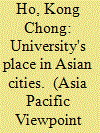| Srl | Item |
| 1 |
ID:
134158


|
|
|
|
|
| Publication |
2014.
|
| Summary/Abstract |
In a context of growing global interconnectivity, policy makers and academics increasingly see knowledge as an essential part of the economic and social development of cities (Bathelt et?al., 2004; Storper and Venables, 2004). Because the economies of large cities are the drivers of the national economy, urban universities are often identified as a key institution and major impetus for the creation of knowledge in the city economy: universities are viewed as spaces for innovation and developing industry linkages, as part of the broader reputation of cities themselves and as sites for the training of future skilled workforces (McCarney, 2005; Goddard and Vallance, 2013). Universities are also an important dimension of the broader urban fabric, having impacts on local economies and geographies, and employing and educating large numbers of faculty, staff and students (Wiewel and Perry, 2008). The presence and practices of domestic and international students are significant not only within the bounds of the campus but also as 'urban agents' involved in the transformation of urban landscapes (Collins, 2010). Housing and the broader urban environments within which students live and study have become an important focus for policy and strategies within local government and universities themselves (Smith, 2008; Fincher and Shaw, 2009).
|
|
|
|
|
|
|
|
|
|
|
|
|
|
|
|
| 2 |
ID:
134161


|
|
|
|
|
| Publication |
2014.
|
| Summary/Abstract |
This paper highlights the relationship between the largest cities in East Asia and the comprehensive research universities that are located there. We look at three strands in this relationship. The first involves students and their perception of host cities, which provides a better understanding of student life and how this connects to the social-cultural environment of the city. The second strand examines the relationship between the university and industry, showing how such collaborations represent university products and knowledge spillovers that connect the university to the metropolitan economy. By examining where students plan to go after graduation, the third strand indicates that the city not only receives student migrants studying in metropolitan universities, it also receives graduates from other East Asian universities. Such third country choices (not returning home or staying in the host country) suggest a new after-study mobility and a small but growing pool of students who are likely to remain in East Asia's largest cities after graduation.
|
|
|
|
|
|
|
|
|
|
|
|
|
|
|
|